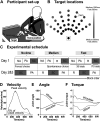Effort, success, and side of lesion determine arm choice in individuals with chronic stroke
- PMID: 34879206
- PMCID: PMC8782657
- DOI: 10.1152/jn.00532.2020
Effort, success, and side of lesion determine arm choice in individuals with chronic stroke
Abstract
In neurotypical individuals, arm choice in reaching movements depends on expected biomechanical effort, expected success, and a handedness bias. Following a stroke, does arm choice change to account for the decreased motor performance, or does it follow a preinjury habitual preference pattern? Participants with mild-to-moderate chronic stroke who were right-handed before stroke performed reaching movements in both spontaneous and forced-choice blocks, under no-time, medium-time, and fast-time constraint conditions designed to modulate reaching success. Mixed-effects logistic regression models of arm choice revealed that expected effort predicted choices. However, expected success only strongly predicted choice in left-hemiparetic individuals. In addition, reaction times decreased in left-hemiparetic individuals between the no-time and the fast-time constraint conditions but showed no changes in right-hemiparetic individuals. Finally, arm choice in the no-time constraint condition correlated with a clinical measure of spontaneous arm use for right-, but not for left-hemiparetic individuals. Our results are consistent with the view that right-hemiparetic individuals show a habitual pattern of arm choice for reaching movements relatively independent of failures. In contrast, left-hemiparetic individuals appear to choose their paretic left arm more optimally: that is, if a movement with the paretic arm is predicted to be not successful in the upcoming movement, the nonparetic right arm is chosen instead.NEW & NOTEWORTHY Although we are seldom aware of it, we constantly make decisions to use one arm or the other in daily activities. Here, we studied whether these decisions change following stroke. Our results show that effort, success, and side of lesion determine arm choice in a reaching task: whereas left-paretic individuals modified their arm choice in response to failures in reaching the target, right-paretic individuals showed a pattern of choice independent of failures.
Keywords: arm choice; chronic stroke; habits; reaching; value-based models of choice.
Conflict of interest statement
No conflicts of interest, financial or otherwise, are declared by the authors.
Figures






Similar articles
-
Arm use after left or right hemiparesis is influenced by hand preference.Stroke. 2009 Feb;40(2):545-50. doi: 10.1161/STROKEAHA.108.528497. Epub 2008 Dec 24. Stroke. 2009. PMID: 19109543
-
Contralesional Arm Preference Depends on Hemisphere of Damage and Target Location in Unilateral Stroke Patients.Neurorehabil Neural Repair. 2014 Jul;28(6):584-93. doi: 10.1177/1545968314520720. Epub 2014 Feb 11. Neurorehabil Neural Repair. 2014. PMID: 24523143 Free PMC article.
-
Effects of vocalization on elbow motion during reaching in persons with hemiparetic stroke.NeuroRehabilitation. 2009;25(2):123-8. doi: 10.3233/NRE-2009-0507. NeuroRehabilitation. 2009. PMID: 19822943
-
Exploiting interlimb coupling to improve paretic arm reaching performance in people with chronic stroke.Arch Phys Med Rehabil. 2005 Nov;86(11):2131-7. doi: 10.1016/j.apmr.2005.05.006. Arch Phys Med Rehabil. 2005. PMID: 16271560
-
Relevant factors for arm choice in reaching movement: a scoping review.J Phys Ther Sci. 2022 Dec;34(12):804-812. doi: 10.1589/jpts.34.804. Epub 2022 Dec 1. J Phys Ther Sci. 2022. PMID: 36507080 Free PMC article.
Cited by
-
Autonomy support encourages use of more-affected arm post-stroke.J Neuroeng Rehabil. 2023 Sep 7;20(1):116. doi: 10.1186/s12984-023-01238-0. J Neuroeng Rehabil. 2023. PMID: 37679781 Free PMC article.
-
Virtuous and Vicious Cycles of Arm Use and Function Post-stroke.Front Neurol. 2022 Mar 29;13:804211. doi: 10.3389/fneur.2022.804211. eCollection 2022. Front Neurol. 2022. PMID: 35422752 Free PMC article.
-
Reaching the cognitive-motor interface: effects of cognitive load on arm choice and motor performance after stroke.Exp Brain Res. 2024 Dec;242(12):2785-2797. doi: 10.1007/s00221-024-06939-z. Epub 2024 Oct 12. Exp Brain Res. 2024. PMID: 39395059 Free PMC article.
-
Impact of unilateral and bilateral impairments on bimanual force production following stroke.J Neurophysiol. 2023 Sep 1;130(3):608-618. doi: 10.1152/jn.00125.2023. Epub 2023 Aug 2. J Neurophysiol. 2023. PMID: 37529847 Free PMC article.
-
Force reserve predicts compensation in reaching movement with induced shoulder strength deficit.J Neurophysiol. 2024 Aug 1;132(2):470-484. doi: 10.1152/jn.00143.2024. Epub 2024 Jul 10. J Neurophysiol. 2024. PMID: 38985941 Free PMC article.
References
Publication types
MeSH terms
Grants and funding
LinkOut - more resources
Full Text Sources
Medical

